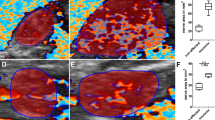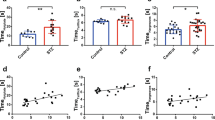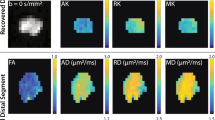Abstract
Currently, the evaluation of peripheral nerve disorders depends on clinical examination, supplemented by electrophysiological studies. These approaches provide general information on the distribution and classification of nerve lesions—for example, axonal versus demyelinative—but nerve biopsies are still required to obtain morphological and pathophysiological details. In this article, we review recent progress in the imaging of peripheral nerve injury by magnetic resonance (MR) neurography. Axonal nerve injury leads to Wallerian degeneration, resulting in a hyperintense nerve signal on T2-weighted MR images of the distal nerve segment. This signal is lost following successful regeneration. Concomitant denervation-induced signal alterations in muscles can further help us to determine whether nerve trunks or roots are affected. These signal changes are caused by various combinations of nonspecific tissue alterations, however, and are not related to particular pathoanatomical findings, such as inflammation, demyelination or axonal injury. New experimental MR contrast agents, such as gadofluorine M and superparamagnetic iron oxide particles, allow visualization of the dynamics of peripheral nerve injury and repair. Further clinical development of these MR contrast agents should allow these functional aspects of nerve injury and repair to be assessed in humans, thereby aiding the differential diagnosis of peripheral nerve disorders.
Key Points
-
MRI is an indispensable tool in the diagnosis of CNS disorders, but is only just beginning to be applied to diseases of the peripheral nervous system
-
Lesioned nerves reveal a marked prolongation of the T2-relaxation time, and consequently they appear bright on T2-weighted MRI. Prolongation of the T2-relaxation time is also observed in acutely denervated muscle
-
Functional and electrophysiological studies substantiate a close relationship between return of motor function and regression of muscle signal hyperintensity
-
In humans, MRI has been shown to have considerable value in the diagnosis of entrapment neuropathies, and also shows promise for the evaluation of traumatic nerve injury and inflammatory nerve lesions
-
As well as revealing muscle hyperintensity on T2-weighted images, MRI might also reveal morphological changes, such as muscle-fiber loss and interposition of fat tissue
-
The limitations of MRI as a diagnostic tool are mainly attributable to the lack of specificity of signal changes. Novel contrast agents are being developed to overcome these limitations
This is a preview of subscription content, access via your institution
Access options
Subscribe to this journal
Receive 12 print issues and online access
$209.00 per year
only $17.42 per issue
Buy this article
- Purchase on Springer Link
- Instant access to full article PDF
Prices may be subject to local taxes which are calculated during checkout






Similar content being viewed by others
References
Thompson PD and Thomas PK (2005) Clinical patterns of peripheral neuropathy. In Peripheral Neuropathy, edn 4, 1137–1161 (Eds Dyck PJ and Thomas PK) Philadelphia: Elsevier Saunders
Dyck PJ et al. (2005) Pathologic alterations of nerves. In Peripheral Neuropathy, edn 4, 733–829 (Eds Dyck PJ and Thomas PK) Philadelphia: Elsevier Saunders
Aagaard BD et al. (2003) High-resolution magnetic resonance imaging is a noninvasive method of observing injury and recovery in the peripheral nervous system. Neurosurgery 53: 199–203
Titelbaum DS et al. (1989) Wallerian degeneration and inflammation in rat peripheral nerve detected by in vivo MR imaging. AJNR Am J Neuroradiol 10: 741–746
Stanisz GJ et al. (2001) MR properties of rat sciatic nerve following trauma. Magnet Reson Med 45: 415–420
Cudlip SA et al. (2002) Magnetic resonance neurography of peripheral nerve following experimental crush injury, and correlation with functional deficit. J Neurosurg 96: 755–775
Bendszus M et al. (2004) MRI of peripheral nerve degeneration and regeneration: correlation with electrophysiology and histology. Exp Neurol 188: 171–177
Does MD and Snyder RE (1996) Multiexponential T2 relaxation in degenerating peripheral nerve. Magn Reson Med 35: 207–213
Polak JF et al. (1988) Magnetic resonance imaging of skeletal muscle. Prolongation of T1 and T2 subsequent to denervation. Invest Radiol 23: 365–369
Bendszus M et al. (2002) Sequential MR imaging of denervated muscle: experimental study. AJNR Am J Neuroradiol 23: 1427–1431
Wessig C et al. (2004) Muscle magnetic resonance imaging of denervation and reinnervation: correlation with electrophysiology and histology. Exp Neurol 185: 254–261
Kikuchi Y et al. (2003) MR imaging in the diagnosis of denervated and reinnervated skeletal muscles: experimental study in rats. Radiology 229: 861–867
Hayashi Y et al. (1997) Effect of peripheral nerve injury on nuclear magnetic resonance relaxation times of rat skeletal muscle. Invest Radiol 32: 135–139
Kullmer K et al. (1998) Changes of sonographic, magnetic resonance tomographic, electromyographic, and histopathologic findings within a 2-month period of examinations after experimental muscle denervation. Arch Orthop Trauma Surg 117: 228–234
Bendszus M and Koltzenburg M (2001) Visualization of denervated muscle by gadolinium enhanced MRI. Neurology 57: 1709–1711
Howe FA et al. (1992) Magnetic resonance neurography. Magn Reson Med 28: 328–338
Filler AG et al. (1993) Magnetic resonance neurography. Lancet 341: 659–661
Moore KR et al. (2001) The value of MR neurography for evaluating extraspinal neuropathic leg pain: a pictorial essay. AJNR Am J Neuroradiol 22: 786–794
Kuntz C et al. (1996) Magnetic resonance neurography of peripheral nerve lesions in the lower extremity. Neurosurgery 39: 750–756
Filler A et al. (1996) Application of magnetic resonance neurography in the evaluation of patients with peripheral nerve pathology. J Neurosurg 85: 299–309
Maravilla KR and Bowen BC (1998) Imaging of the peripheral nervous system: evaluation of peripheral neuropathy and plexopathy. AJNR Am J Neuroradiol 19: 1011–1023
Chappell KE et al. (2004) Magic angle effects in MR neurography. AJNR Am J Neuroradiol 25: 431–440
Grant GA et al. (2002) The utility of magnetic resonance imaging in evaluating peripheral nerve disorders. Muscle Nerve 25: 314–331
Jarvik JG et al. (2002) MR nerve imaging in a prospective cohort of patients with suspected carpal tunnel syndrome. Neurology 58: 1597–1602
Cudlip SA et al. (2002) Magnetic resonance neurography studies of the median nerve before and after carpal tunnel decompression. J Neurosurg 96: 1046–1051
Britz GW et al. (1996) Ulnar nerve entrapment at the elbow: correlation of magnetic resonance imaging, clinical, electrodiagnostic, and intraoperative findings. Neurosurgery 38: 458–465
Koltzenburg M and Bendszus M (2004) Imaging of peripheral nerve lesions. Curr Opin Neurol 17: 621–626
Panegyres PK et al. (1993) Thoracic outlet syndromes and magnetic resonance imaging. Brain 116: 823–841
Dailey AT et al. (1996) Magnetic resonance neurography for cervical radiculopathy: a preliminary report. Neurosurgery 38: 488–492
Bendszus M et al. (2003) A novel painful vascular compression syndrome of the sciatic nerve caused by gluteal varicosis. Neurology 61: 985–987
Bendszus M et al. (2002) Peroneal nerve palsy caused by thrombosis of crural veins. Neurology 58: 1675–1677
Stoll G and Muller HW (1999) Nerve injury, axonal degeneration and neural regeneration: basic insights. Brain Pathol 9: 313–325
Dailey AT et al. (1997) Magnetic resonance neurography of peripheral nerve degeneration and regeneration. Lancet 350: 1221–1222
Gorson KC et al. (1996) Prospective evaluation of MRI lumbosacral nerve root enhancement in acute Guillain–Barré syndrome. Neurology 47: 813–817
Byun WM et al. (1998) Guillain–Barré syndrome: MR imaging findings of the spine in eight patients. Radiology 208: 137–141
Duggins AJ et al. (1999) Spinal root and plexus hypertrophy in chronic inflammatory demyelinating polyneuropathy. Brain 122: 1383–1390
Kuwabara S et al. (1997) Magnetic resonance imaging at the demyelinative foci in chronic inflammatory demyelinating polyneuropathy. Neurology 48: 874–877
Crino PB et al. (1993) Magnetic resonance imaging of the cauda equina in chronic inflammatory demyelinating polyneuropathy. Ann Neurol 33: 311–313
Fee DB and Fleming JO (2003) Resolution of chronic inflammatory demyelinating polyneuropathy-associated central nervous system lesions after treatment with intravenous immunoglobulin. J Peripher Nerv Syst 8: 155–158
Georgy BA et al. (1999) MR imaging of spinal nerve roots: techniques, enhancement patterns, and imaging findings. AJR Am J Roentgenol 166: 173–179
Ellegala DB et al. (2005) Characterization of genetically defined types of Charcot–Marie–Tooth neuropathies by using magnetic resonance neurography. J Neurosurg 102: 242–245
Shabas D and Gerad G (1986) Magnetic resonance in neuromuscular disorders. Sem Neurol 6: 94–99
West GA et al. (1994) Magnetic resonance imaging signal changes in denervated muscles after peripheral nerve injury. Neurosurgery 35: 1077–1086
Fleckenstein J et al. (1993) Denervated human skeletal muscle: MR imaging evaluation. Radiology 187: 213–218
Uetani M et al. (1993) Denervated skeletal muscle: MR imaging. Radiology 189: 511–515
Bendszus M et al. (2003) Magnetic-resonance-imaging (MR) of the lower leg compared to the clinical and electrophysiological examination in the differential diagnosis of neurogenic foot drop. AJNR Am J Neuroradiol 24: 1283–1289
Jonas D et al. (2000) Correlation between quantitative EMG and muscle MRI in patients with axonal neuropathy. Muscle Nerve 23: 1265–1269
McDonald CM et al. (2000) Magnetic resonance imaging of denervated muscle: comparison to electromyography. Muscle Nerve 23: 1431–1434
Bendszus M and Koltzenburg M (2002) Footdrop after peroneal nerve lesion. J Neurol Neurosurg Psychiatr 72: 42
Bendszus M et al. (2005) In vivo assessment of nerve degeneration and regeneration by gadofluorine M enhanced magnetic resonance imaging. Ann Neurol 57: 388–395
Bendszus M and Stoll G (2003) Caught in the act: in vivo mapping of macrophage infiltration in nerve injury by magnetic resonance imaging. J Neurosci 23: 10892–10896
Toews AD et al. (1998) Monocyte chemoattractant protein 1 is responsible for macrophage recruitment following injury to sciatic nerve. J Neurosci Res 15: 260–267
Stoll G et al. (2004) In vivo monitoring of macrophage infiltration in experimental autoimmune neuritis by magnetic resonance imaging. J Neuroimmunol 149: 142–146
Acknowledgements
We thank K Reiners and L Solymosi for helpful comments, and KV Toyka for support and critical reading of the manuscript. MB holds a professorship donated by Schering GmbH, Berlin, Germany, to the University of Wuerzburg, but has no financial interest. This work was in part supported by the IZKF, Wuerzburg (grant F-20).
Author information
Authors and Affiliations
Corresponding author
Ethics declarations
Competing interests
The authors declare no competing financial interests.
Rights and permissions
About this article
Cite this article
Bendszus, M., Stoll, G. Technology Insight: visualizing peripheral nerve injury using MRI. Nat Rev Neurol 1, 45–53 (2005). https://doi.org/10.1038/ncpneuro0017
Received:
Accepted:
Issue Date:
DOI: https://doi.org/10.1038/ncpneuro0017
This article is cited by
-
Quantification and Proximal-to-Distal Distribution Pattern of Tibial Nerve Lesions in Relapsing-Remitting Multiple Sclerosis
Clinical Neuroradiology (2023)
-
Improving outcomes in traumatic peripheral nerve injuries to the upper extremity
European Journal of Orthopaedic Surgery & Traumatology (2023)
-
Magnetization Transfer Ratio of Peripheral Nerve and Skeletal Muscle
Clinical Neuroradiology (2022)
-
Routine knee MRI: how common are peripheral nerve abnormalities, and why does it matter?
Skeletal Radiology (2021)
-
Bildgebung der Hand
Der Radiologe (2021)



